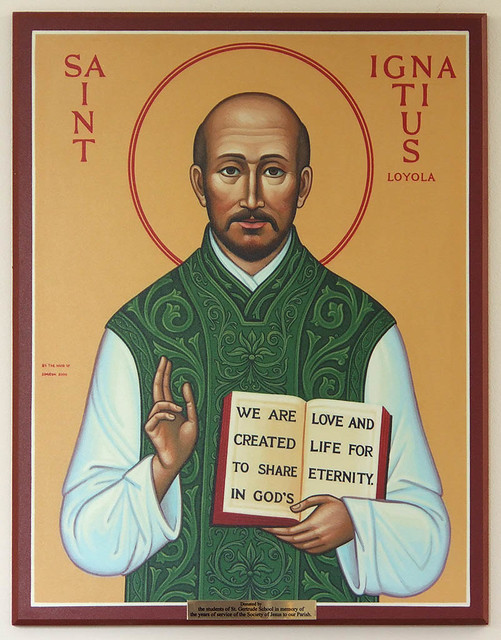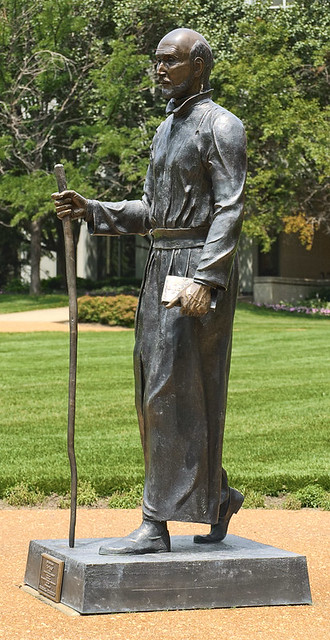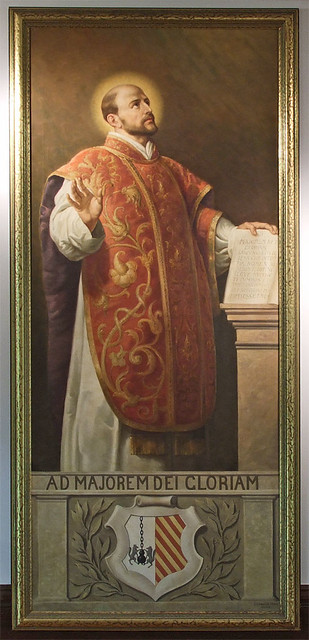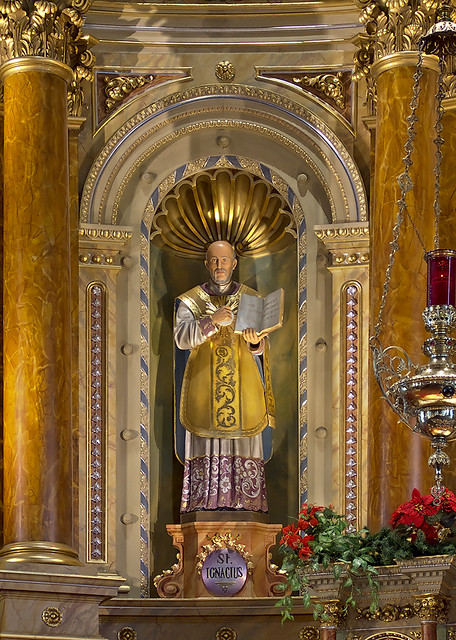
Icon at Saint Gertrude Church, in Krakow, Missouri. Photo taken in May, 2007.
“Up to his twenty-sixth year the heart of Ignatius was enthralled by the vanities of the world. His special delight was in the military life, and he seemed led by a strong and empty desire of gaining for himself a great name. The citadel of Pampeluna was held in siege by the French. All the other soldiers were unanimous in wishing to surrender on condition of freedom to leave, since it was impossible to hold out any longer; but Ignatius so persuaded the commander, that, against the views of all the other nobles, he decided to hold the citadel against the enemy…”

Statue of Saint Ignatius of Loyola (“The Pilgrim” by Vicki Reid), at Saint Louis University, in Saint Louis, Missouri. Photo taken in June, 2009.

At Saint Ignatius Loyola Church, in Concord Hill, Missouri. Photo taken in July, 2007.
Ignatius was severely wounded in battle, and was captured by the French. However, his captors admired Ignatius for his great courage. He then had to spend much time in recovery:
“As Ignatius had a love for fiction, when he found himself out of danger he asked for some [chivalric] romances to pass away the time. In that house there was no book of the kind. They gave him, instead, “The Life of Christ” by Ludolph, the Carthusian, and another book called the “Flowers of the Saints,” both in Spanish. By frequent reading of these books he began to get some love for spiritual things. This reading led his mind to meditate on holy things, yet sometimes it wandered to thoughts which he had been accustomed to dwell upon before.— From The Autobiography of St. Ignatius: The Account of his Life dictated to Father Gonzalez by St. Ignatius
“Among these there was one thought which, above the others, so filled his heart that he became, as it were, immersed and absorbed in it. Unconsciously, it engaged his attention for three and four hours at a time. He pictured to himself what he should do in honor of an illustrious lady, how he should journey to the city where she was, in what words he would address her, and what bright and pleasant sayings he would make use of, what manner of warlike exploits he should perform to please her. He was so carried away by this thought that he did not even perceive how far beyond his power it was to do what he proposed, for she was a lady exceedingly illustrious and of the highest nobility.
“In the meantime the divine mercy was at work substituting for these thoughts others suggested by his recent readings. While perusing the life of Our Lord and the saints, he began to reflect, saying to himself: "What if I should do what St. Francis did?" "What if I should act like St. Dominic?" He pondered over these things in his mind, and kept continually proposing to himself serious and difficult things. He seemed to feel a certain readiness for doing them, with no other reason except this thought: "St. Dominic did this; I, too, will do it." "St. Francis did this; therefore I will do it." These heroic resolutions remained for a time, and then other vain and worldly thoughts followed. This succession of thoughts occupied him for a long while, those about God alternating with those about the world. But in these thoughts there was this difference. When he thought of worldly things it gave him great pleasure, but afterward he found himself dry and sad. But when he thought of journeying to Jerusalem, and of living only on herbs, and practicing austerities, he found pleasure not only while thinking of them, but also when he had ceased.
“This difference he did not notice or value, until one day the eyes of his soul were opened and he began to inquire the reason of the difference. He learned by experience that one train of thought left him sad, the other joyful. This was his first reasoning on spiritual matters. Afterward, when he began the Spiritual Exercises, he was enlightened, and understood what he afterward taught his children about the discernment of spirits. When gradually he recognized the different spirits by which he was moved, one, the spirit of God, the other, the devil, and when he had gained no little spiritual light from the reading of pious books, he began to think more seriously of his past life, and how much penance he should do to expiate his past sins.”

At the Collection of the Western Jesuit Missions, Saint Louis University Museum of Art. Photo taken in December, 2006.

At the Shrine of Saint Joseph, in Saint Louis. Photo taken January, 2008.


Thank you for all of the beautiful pictures of St. Ignatius. A great post.
ReplyDeletehttp://afterthemass.blogspot.com/